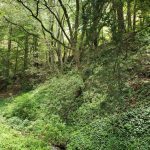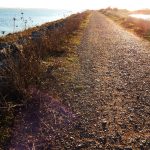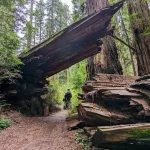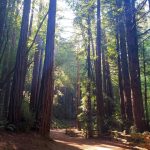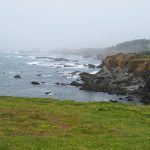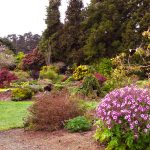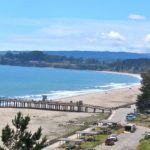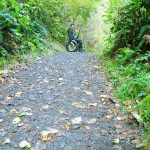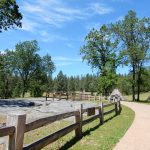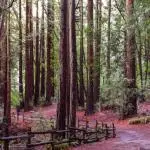Thirty miles north of Eureka, in the heart of the redwood country, Patrick’s Point State Park juts into the Pacific Ocean on a 640-acre headland with forests of spruce, pine, fir, hemlock, and alder interspersed with meadows.
Although this coast is often shrouded in fog, on a clear day (typically spring and fall) you can enjoy stunning blufftop views at Wedding Rock, Patrick’s Point, and Palmer’s Point. From these vantage points, you can look for gray whales during their spring and fall migrations, California sea lions, stellar sea lions, and harbor seals. Bountiful spring wildflowers, including Douglas iris, fairy bells, and trillium, grace the meadows and forests. Abundant berries are found throughout summer, while fall and winter bring out a variety of mushrooms—over 500 species have been collected. Black-tailed deer are a common sight as they graze on the bluffs and grasslands.
A highlight of the park is a replica of a Yurok village, known as Sumêg. Built in 1990 by local Yuroks using traditional construction techniques, it consists of a dance pit, changing houses, a sweat house, and family houses. All can be viewed from a moderately accessible trail. The Yurok use this village for dances and ceremonies to pass cultural traditions on to their young people.
Several miles of interconnected trails wind throughout the park, but most are inaccessible to wheelchair riders due to steep, rough terrain. However, the paved road that meanders through forests, meadows, and campgrounds has little traffic and offers a great way to explore the park. An adventurous person using a manual wheelchair may, with good upper body strength and some assistance, be able to navigate some of the wider, firm trails, but will encounter an abundance of tree roots. Both Patrick’s Point Trail and Sumêg Village are accessible, and according to State Parks, the Campfire Center Trail from Abalone Campground to the Campfire Center is also accessible. See access criteria for definitions.
Sumêg Trail
On my visit in late April, a few large rhododendrons at the trailhead looked ready to burst with color. The trail winds through a Sitka spruce and Douglas fir forest, lush with ferns and moss. After a short uphill stretch, you come to a redwood canoe exhibit. Yuroks built their canoes from naturally fallen redwood trees and generally took several years to finish one because they worked on them only after the day’s chores were completed. They built canoes in various sizes, and while the one on display is small, the larger ones weighed 1,000 pounds and reached 40 to 50 feet in length.
About a hundred feet beyond the canoe is a spur trail to Ceremonial Rock, which, given its name, I should have guessed would be inaccessible—the terrain quickly becomes steep and rough, and there’s a step up to a bridge. Another hundred feet past the spur is a trail to the native plant garden, where you can see plants used by the Yurok for medicines, baskets, and ceremonial purposes. I found this tree-lined trail manageable in a motorized wheelchair, but it took some careful navigating. It was a bit overgrown and untended but may be better maintained during the park’s busier months.
The forest’s cool, damp air was filled with birdsong and rays of sunlight, and an abundance of blooming white trillium lightened the landscape as well, but a few hundred yards beyond the native plant garden, when I reached the open meadow of Sumêg Village, my spirit soared in the welcome warmth of the sun. Here you can continue on the wide trail as it skirts the village structures, or cross a grassy meadow as I did, to get a closer view of the structures—this route is quite bumpy and may be challenging in a manual wheelchair. The main path leads to the cook shelter, where you can get close to one of the changing houses–used as changing rooms by the Brush Dancers of various tribes, including Yurok, Karuk, and Hoopa–and the dance pit. The people of Sumêg regarded their houses as living beings and the redwood they were made from as a spirit, and their first loyalty was not to a tribe or village, but to their home.
We tried to return to the visitor center on other trails but found all of them extremely bumpy with tree roots, so returned the way we came. It is possible to drive to the Sumêg Village instead of taking the trail.
- Trailhead: Adjacent to the visitor center
- Length: Less than .5 mile
- Typical Width: 4 ft. & above. Trail width may be less than four feet in places where you have to navigate around tree roots. The native plant garden paths narrow to less than three feet in places, due to rocks and trees.
- Typical Grade: Gentle. A short uphill that you encounter about 50 feet into the native plant garden may be greater than 1:12.
Terrain: Moderately Firm. Several spots require careful maneuvering over tree roots. I easily managed in my motorized chair, but the ride was quite bumpy. The duff on the forest floor was thick in places and may cause drag on manual wheelchairs.
Patrick’s Point
This short (500-foot) trail that hugs the blufftop is worth a stop for its expansive views of the ocean. A few feet from the starting point, bear right at the fork; to the left is the inaccessible Rim Trail. Continue to the first overlook, with views to the south. The next overlook is much bigger and looks north, with Wedding Rock a short distance offshore. You might see migrating gray whales, sea lions, or seals playing in the waves or lounging on the rocks below.
- Trailhead: Wedding Rock parking lot
- Length: Less than .5 mile
- Typical Width: 4 ft. & above
- Typical Grade: Gentle
One grade near the beginning may be slightly greater than 1:12. - Terrain: Moderately Firm
Accessibility Details
The facilities listed below meet all of our access criteria unless otherwise noted.
- Accessible Visitor Center: Yes. A stop at the visitor center, just inside the park entrance, will greatly enhance your visit to this park. You will learn about the Yurok, who inhabit coastal Humboldt County and have traditionally come to Patrick’s Point in the summer to fish and hunt. Displays include Indian baskets and tools, birds of the forest, and animal specimens, including a gray whale skull, gray fox, and brown bear. Don’t miss the have-to-see-it-to-believe-it “elk tree,”––a tree that grew around an elk’s head after the animal got its antlers stuck in the trunk and died. Interactive exhibits invite you to guess which animal made which tracks and to feel animal bones and other specimens. Be sure to pick up a free brochure about the Sumêg Village if you plan to hike the Sumêg Trail.
- Accessible Parking: Yes. At the visitor center, Patrick’s Point, Palmer’s Point, Mussel Rocks, Lookout Rock, Campfire Center, and Sumêg Village; the last is on a slight slope and has no access aisle.
- Accessible Restroom: Yes. Adjacent to the visitor center, near the parking lot at Sumêg Village, and at Mussel Rocks overlook, Lookout Rock, and the Campfire Center; a portable unit is at Palmer’s Point.
- Accessible Picnic Tables: Yes. The most accessible tables are at the visitor center, where they are scattered on a large deck surrounded by trees; in the Sumêg Village by the cook shelter; and at Mussel Rocks parking lot. At all other locations they are on mostly level and firm surfaces but you must travel across the grass to reach them.
Additional Information
- Hours: Day use: Sunrise-sunset and the visitor center is open Memorial Day to Labor Day Daily, 9 am-5 pm; variable at other times of year
- Maps: See here.
- Fees: Entrance
- Dogs: Allowed in restricted areas and not allowed on trails or beach
- Other Things of Interest: Nearby Trinidad State Beach in picturesque, historic Trinidad has an accessible day-use picnic area on a bluff overlooking the beach. On my visit the restrooms were locked, so I was unable to assess their accessibility.



